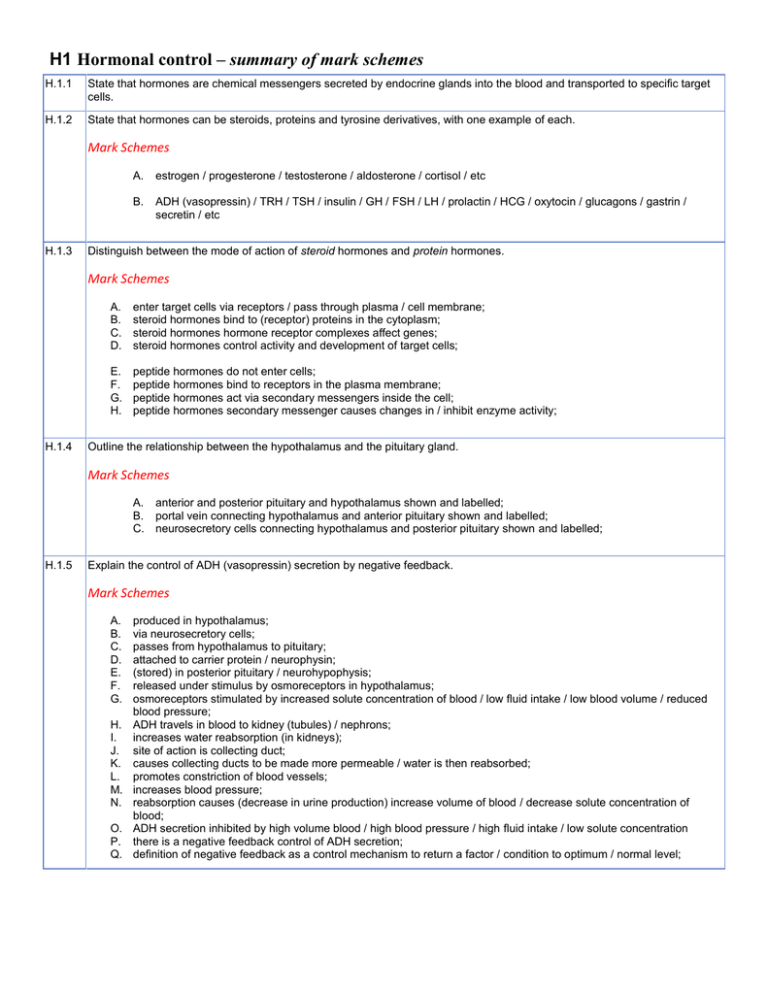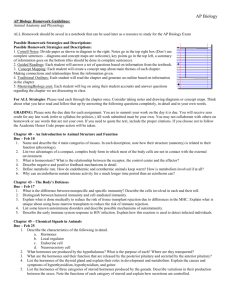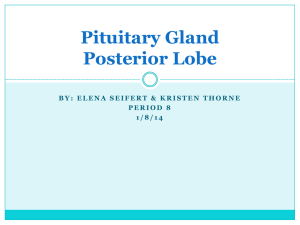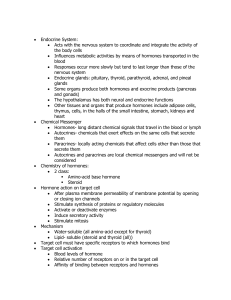summary of mark schemes
advertisement

H1 Hormonal control – summary of mark schemes H.1.1 State that hormones are chemical messengers secreted by endocrine glands into the blood and transported to specific target cells. H.1.2 State that hormones can be steroids, proteins and tyrosine derivatives, with one example of each. Mark Schemes H.1.3 A. estrogen / progesterone / testosterone / aldosterone / cortisol / etc B. ADH (vasopressin) / TRH / TSH / insulin / GH / FSH / LH / prolactin / HCG / oxytocin / glucagons / gastrin / secretin / etc Distinguish between the mode of action of steroid hormones and protein hormones. Mark Schemes H.1.4 A. B. C. D. enter target cells via receptors / pass through plasma / cell membrane; steroid hormones bind to (receptor) proteins in the cytoplasm; steroid hormones hormone receptor complexes affect genes; steroid hormones control activity and development of target cells; E. F. G. H. peptide hormones do not enter cells; peptide hormones bind to receptors in the plasma membrane; peptide hormones act via secondary messengers inside the cell; peptide hormones secondary messenger causes changes in / inhibit enzyme activity; Outline the relationship between the hypothalamus and the pituitary gland. Mark Schemes A. B. C. H.1.5 anterior and posterior pituitary and hypothalamus shown and labelled; portal vein connecting hypothalamus and anterior pituitary shown and labelled; neurosecretory cells connecting hypothalamus and posterior pituitary shown and labelled; Explain the control of ADH (vasopressin) secretion by negative feedback. Mark Schemes A. B. C. D. E. F. G. produced in hypothalamus; via neurosecretory cells; passes from hypothalamus to pituitary; attached to carrier protein / neurophysin; (stored) in posterior pituitary / neurohypophysis; released under stimulus by osmoreceptors in hypothalamus; osmoreceptors stimulated by increased solute concentration of blood / low fluid intake / low blood volume / reduced blood pressure; H. ADH travels in blood to kidney (tubules) / nephrons; I. increases water reabsorption (in kidneys); J. site of action is collecting duct; K. causes collecting ducts to be made more permeable / water is then reabsorbed; L. promotes constriction of blood vessels; M. increases blood pressure; N. reabsorption causes (decrease in urine production) increase volume of blood / decrease solute concentration of blood; O. ADH secretion inhibited by high volume blood / high blood pressure / high fluid intake / low solute concentration P. there is a negative feedback control of ADH secretion; Q. definition of negative feedback as a control mechanism to return a factor / condition to optimum / normal level;







